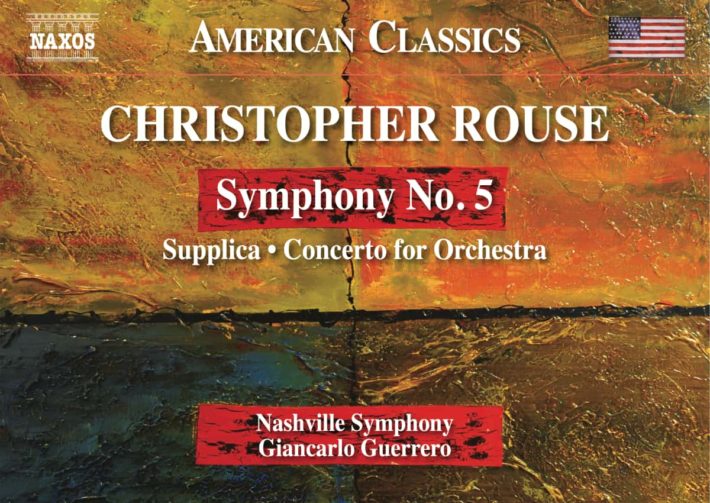Christopher Rouse’s death in 2019 was a significant loss for the classical music world. One of America’s most prominent contemporary composers, his substantial orchestral oeuvre often utilizes a large orchestra and dense, often incessantly busy, textures. His harmonic language is tonal, though it often employs dissonance. This interesting release includes reletavely late works from 2008 to 2015, two of which are world premier recordings.
The album opens with Symphony No. 5, jointly commissioned by the Dallas Symphony Orchestra, the Nashville Symphony, and the Aspen Music Festival. Completed in February 2015, Rouse writes that Beethoven’s Fifth Symphony was the first piece of classical music he remembers hearing. It was very much on his mind when composing his own fifth Symphony, so Rouse interweaves various elements from Beethoven’s symphony into his own. A particularly pleasurable aspect of listening to Rouse’s symphony is finding those elements.
Rouse’s symphony, in one continuous movement, breaks down into four major sections. The first revels in the power and virtuosity of the modern orchestra, unleashing an explosive salvo dominated by powerful brass and percussion. Its inexorable busyness whirls by in seven-plus minutes (note how often the short-short-short-long motif of Beethoven’s symphony is used). At 7’49” the music is suddenly stopped in its track and the slow movement begins, featuring some achingly beautiful writing for the woodwinds. Wandering harmonies create an atmosphere of serenity, at times rudely interrupted by the lower brass (13’00”).
In the scherzo section (17’35”), Rouse makes another reference to Beethoven: Rouse brings back music from the slow section (an idea taken from the final movement of Beethoven’s Symphony). The final section brings a return to the raucous energy and speed of the opening section. Its powerful rhythmic drive builds to an awesome brass and percussion-led climax (listen to the fabulous timpani tattoo at 25’40”), finishing with a coda brimming with jazzy hyperactive optimism, music that would drive any audience to its feet.
What an incredible orchestra Nashville has become. Under Kenneth Schermerhorn, Nashville’s previous conductor, the orchestra developed into a first-rate regional ensemble. But their current director, Giancarlo Guerrero, has brought them to a level that rivals the best American orchestras. If perhaps they lack the finesse and refinement found in Boston and Cleveland, their unbridled enthusiasm and intense energy are a joy to hear. Strings play with nimble virtuosity, dispatching Rouse’s difficult writing with disarming aplomb. Woodwinds have plenty of character in solos, with an organ-like sonority in ensemble playing. Brass are lyrical and raucous by turn, with especially impressive playing by trombones and tuba. Together, they create a fully compelling and emotionally involving reading of Rouse’s masterful symphony.
Related Classical Music Reviews
- Review: Adès Conducts Adès – Kirill Gerstein, Piano
- Review: Clyne, Elgar – Cello Concertos – Inbal Segev, LPO, Alsop
- Review: “Clytemnestra” – Ruby Hughes, Soprano
“Supplica”, wisely positioned between the Symphony and Concerto for Orchestra, opens with subdued and chromatic string writing, seemingly unmoored from traditional harmonic progression. The music inhabits the same spiritual world as the Adagio from Mahler’s incomplete tenth symphony. Scored for 4 horns, 2 trumpets, 3 trombones, harp and strings, the writing has a dark timbre that is intensely mournful. The trumpet solo at 8’01 recalls “The Unanswered Question” by Charles Ives. The music then progresses towards a climax, perhaps seeking catharsis, but build up suddenly stops, and the movement fades away into a resigned sadness. Guerrero and his Nashville players offer a moving and poignant performance.
The “Concerto for Orchestra” has a particularly fascinating structure. Rouse divides the concerto into connected halves: the first half consists of five short sections – fast, slow, fast, slow, fast. The fast parts share and develop the same musical material, while the slow sections explore different material. The second half of the concerto has a slow and fast section, and in each part materials from the first half are explored and developed more fully.
The music switches texture, dynamic and mood with often alarming abruptness, but Guerrero and his players ensure the shifts have an organic naturalness that is surely the result of careful and intense rehearsal. Incredible virtuosity is required, both in solos and corporately, from every section of the orchestra, and the Nashville players are fully equal to the demands of this difficult music. The woodwind playing is especially impressive, particularly the oboe.
Naxos ancillary materials are very good, even if they rob specific orchestra players from their due credit (no orchestra personal is listed). But the notes by Thomas May, liberally quoting the composer, are informative and interesting. Tim Handley’s engineering is typically first-rate, creating clarity even in the densest textures, with sound that has immediate and visceral impact. This is intensely communicative music that deserves and rewards repeated listening.

Christopher Rouse – Symphony No. 5, Supplica, Concerto for Orchestra
Nashville Symphony
Giancarlo Guerrero – Conductor
Naxos, CD 8559852
Read more classical music reviews or visit The Classic Review Amazon store
Follow Us and Comment:
[wd_hustle id=”HustlePostEmbed” type=”embedded”]











